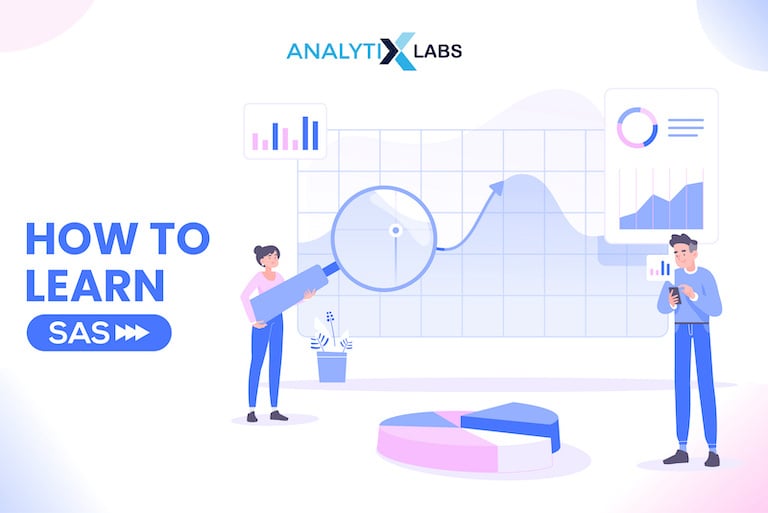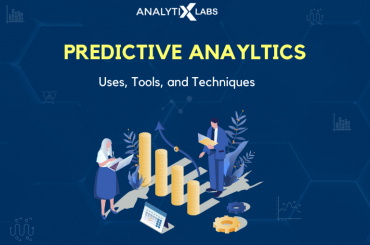Statistical Analysis System, or SAS, offered by the SAS Institute, is an integrated statistical software having varied applications across commercial, government, and academic areas. With being a global market leader for decades and having strong and sound customer bases, a skilled SAS Analyst is always in demand by organizations.
So, SAS is a big-time technological player and is the focal point of this article. We shall look at what is SAS certification, how to learn SAS, what you need to headstart your SAS career, what is Base SAS tutorial is, how can one get Base SAS certification and SAS Programmer certification, and compare the two giant technological tools: SAS and Python across various key factors.
What is SAS certification?
Professionals and students can kickstart their SAS careers by achieving SAS certification. SAS Institute offers SAS Global Certification, including training, e-learning, and certification courses and exams. The certifications are offered across various verticals of analytics. SAS Global Certification Program has certifications across the following five categories:
Foundation Tools
Foundation Tools are for those whose work involves writing and managing SAS programs.
- SAS Certified Base Programmer for SAS 9
- SAS Certified Advanced Programmer for SAS 9
- SAS Certified Clinical Trials Programmer Using SAS 9
Advanced Analytics
Advanced Analytics pertains to acquiring, manipulating, and analyzing big data using SAS tools, running reports, and making business recommendations based on complex models.
- SAS Certified Data Scientist Using SAS 9
- SAS Certified Advanced Analytics Professional Using SAS 9
- SAS Certified Predictive Modeler Using SAS Enterprise Miner 13
- SAS Certified Statistical Business Analyst Using SAS 9: Regression and Modeling
Business Intelligence and Analytics
IT professionals who create interfaces and reports for SAS 9 or use SAS Visual Analytics on routinely basis will benefit from the Business Intelligence and Analytics certifications:
- SAS Certified BI Content Developer for SAS 9
- SAS Certified Visual Business Analyst: Exploration and Design Using SAS Visual Analytics
- SAS Certified Visual Modeler Using SAS Visual Statistics 7.4
Data Management
Data management certifications focus on managing data and platforms, not advanced analytical processes such as deep statistics, analysis, and modeling.
- SAS Certified Big Data Professional Using SAS 9
- SAS Certified Data Integration Developer for SAS 9
- SAS Certified Data Quality Steward for SAS 9
Administration
- SAS Certified Platform Administrator for SAS 9
Administration certification focuses on professionals supporting the SAS Business Analytics platform from installation to day-to-day maintenance activities. One must be versed in setting up folders, managing users’ accounts, monitoring system performance, applying security techniques, performing backups, and completing other administrative tasks.
These certifications do not require any credential prerequisites though having a thorough knowledge of several related skills and techniques is required. SAS certifications do not have mandatory work experience as a requirement.
However, it is indicated for any of the BASE certification exams, a minimum of eight months of experience and two to three years of relevant, hands-on experience for all other certifications are desired.
For more details and pricing of each certification, refer to the official site of SAS and FAQs.
How to learn SAS or How do I become a SAS analyst?
Wondering how to venture into a SAS career and where to start? Stay tuned to find out how! Let’s look at what all you need to do is add SAS skills to your kit:
Download and Install SAS University Edition
The first step is downloading and installing the SAS University edition from the official SAS website. It will provide a foundational and basic understanding of SAS. The free SAS University edition has limited functionality, and its advanced features are for paid.
To download the University edition, you would need to create a SAS profile and also download the virtualization software such as VMWare or Oracle Virtual Box. You can get your copy from here SAS University Edition – download page.
Learn Base SAS
One can start free training and go through the SAS official site; under the ‘My Training’ section, start learning the Base SAS tutorial for free. It can be accessed from How To Tutorials.
The training covers the basics of the SAS language and is 24 hours. Apart from this, use additional free resources available on the internet supporting e-learning.
Learn SQL, Macros, and Statistics
PROC SQL sets the base for SAS, and Macros help to automate tasks. Statistical concepts such as Inferential statistics, Descriptive Statistics, ANOVA, Regression analysis, and advanced topics, namely Decision Trees, Clustering and Segmentation, Time series analysis, and forecasting, are important to work with SAS.
If one is unfamiliar with any or all topics, do invest your energies in learning these as all three SQL, Macros, and Statistics are essential pillars for learning SAS.
Get SAS Certification
If you are interested and serious about having a career in SAS, then you can pursue Base SAS certification and SAS Programmer Certification. Studying and preparing for the certification boosts one’s skills and offers hands-on experience with real industry projects. SAS certification courses cover both basic and advanced topics.
Certification also adds a feather to your credentials as it reflects your commitment, and organizations acknowledge and recognize you as a professional who is dedicated to investing your time and energy in your technical growth.
Additional Resources
Other various resources for SAS can support your SAS learning:
- The Little SAS Book is similar to the bible for SAS learners. It can be supplemented with SAS tutorials
- Developer hubs such as Github are very useful for practicing and sharing your codes and can also benchmark your codes against others and learn from others’ solutions
Is SAS a good career option?
SAS is a good career option. It is certainly a desired skill by companies, and hundreds of jobs demand SAS as a skill set. SAS is an amalgamated software with each of its components catering to offer solutions to different issues.
SAS has been in the market for four decades now. Big financial companies such as JP Morgan, Franklin Templeton, Citibank, HSBC, and Wells Fargo rely heavily on SAS for their analysis. SAS has immense demand in sectors such as banking, insurance, financial, pharmaceutical, and areas involving research and development.
There are plenty of SAS careers based on one’s goral and interests. SAS jobs start from fresher data level to require experienced professionals. Following are examples of job roles based on the SAS certification categories:
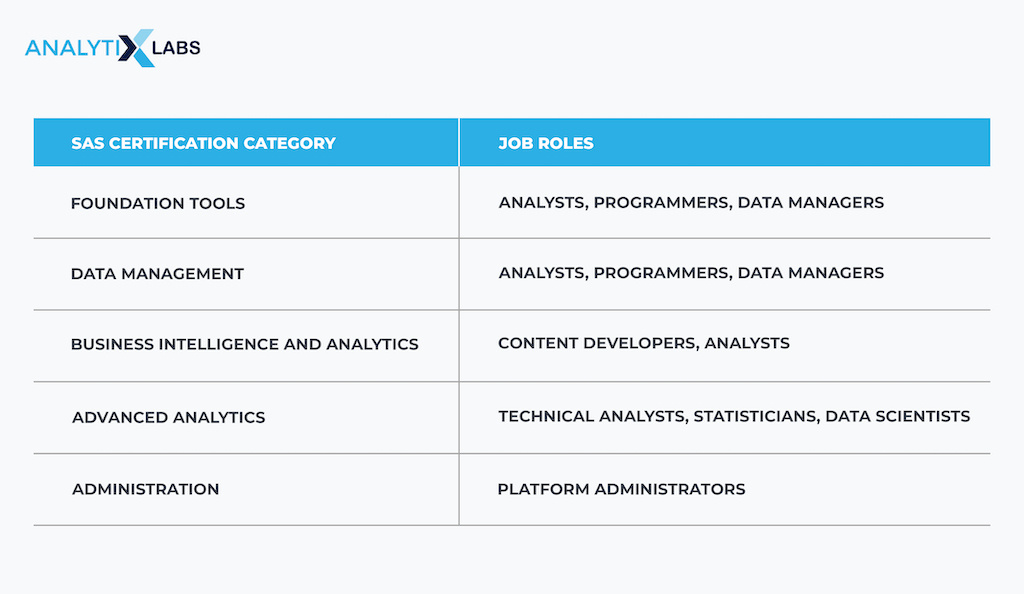
For a data science professional, SAS has advanced tools such as SAS Viya, SAS Enterprise Miner, SAS DataFlux Data Management Studio, and SAS Customer Intelligence. Your SAS and analytics career can be boosted by adding such to your arsenal along with the Base SAS and SAS Programmer certifications. This also offers a higher analytical role in a company.
SAS vs Python
Statistical Analysis System (SAS) is an integrated software system specifically for statistical data analysis and report writing. Large corporations primarily use SAS, namely HSBC, BNB Paribas, Barclays, Nestle, and Volvo. Small businesses and individuals do not majorly apply it.
Python, designed by Guido Van Rossem in 1991, is an open-source, object-oriented programming language with syntax like plain English and is easily readable. Python is extensively used in data science, web, and software development.
It is used by giants such as Google, Microsoft, Facebook, ABN-AMRO, Quora, and Reddit.
There are questions and debates around SAS vs Python. There is no straight answer for which of the two is better. Both SAS and Python have pros and cons but are curated for specific purposes. We can always debate about it, for which we need to look at the common parameters to assess if SAS is better than Python:
-
Cost-effectiveness
SAS is a proprietary, commercial, and licensed software. Though SAS has the highest market share among private companies, it is immensely expensive and, therefore, out of reach for individuals and small and medium-sized businesses.
Only large-scale organizations can invest millions of dollars to purchase a SAS license. The paid SAS software comes with varied features and capabilities that are utilized post-purchase and upgradation.
SAS does offer a free University Edition for students. However, it has limitations in terms of its features and capabilities.
Python is open-source software that is available for free and easily accessible by both professionals and students to download and use it. It is certainly more cost-effective than SAS, as small and medium-sized businesses can use it freely.
-
Accessibility of functionalities
SAS is a closed source and does not support transparent functionalities until its license is purchased. Also, SAS is not time friendly, as it takes longer to familiarize itself with its functionalities.
On the other hand, Python comprises detailed and comprehensive transparency of all its functionalities and algorithms and is more favorable to small and medium-sized organizations.
Though SAS has one major functionality over Python, one can also use Jupyter Notebooks in SAS!
-
Ease of Learning
SAS is one of the easiest languages to learn. One can learn SAS even without having any prior programming skills. Yet, to productively apply SAS, one must have a strong base in PROC SQL.
SAS is more stable and easy to use than Graphic User Interface (GUI) based. SAS offers comprehensive documentation, and many SAS resources and tutorials are available on sites for learning.
Python is easy to learn and understand, given its simplicity, flexibility, and versatility. Python can be learned by newbies who are new to the programming world and also to data science. Though, the learning curve of Python is relatively longer than SAS.
Python does not have a GUI interface like SAS; however, it has an IPython notebook. Python notebooks are very popular and allow easy access to codes. The notebooks have varied features of documentation and sharing.
Moreover, Google also offers the Python notebook as Google Colaboratory, which combines executable code and rich text in a single document.
-
Data Handling Capabilities
SAS has a built-in BI package for storing data and computational capabilities. It is powered to handle data on stand-alone devices or machines. It can smoothly and stably handle data.
Python is excellent at handling vast and complex data and can efficiently clean, store and organize this scattered data. It has numerous packages and libraries curtailing each data science purpose and step, from importing data, data wrangling, visualizing data, statistical analysis, and machine learning to data validation and deployment. Also, it has extensive libraries for natural language processing and deep learning.
Python libraries, Pandas and Numpy, are extensively used for data preprocessing and are a must for data science. Matplotlib and Seaborn for visualization of data, Scipy for statistical analysis, Scikit Learn (or sklearn) for data transformation, machine learning, predictive analytics, NLTK, spacy, gensim for natural language processing, and Keras, TensorFlow, and PyTorch for deep learning.
-
Data Visualization Capabilities
Visualization is a core aspect of data science. SAS offers its primary visualization solution known as SAS Visual Analytics, which is expensive and has only functional graphical capabilities. It can plot basic graphs. Customization of graphs in SAS is challenging as one requires to have good knowledge of the SAS Graph package, which needs configuration.
Unlike SAS, in Python, visualization tools are available for free. Visualization in Python is very strong. Python has both strong data handling and visualization capabilities. In Python, there are graphical libraries and packages such as Visby and Matplotlib, and Matplotlib has an extension library called Seaborn, enabling easy creation of custom graphs and plots.
-
Job Opportunities
SAS has been a market leader in the job market globally. Large corporations are looking for skilled SAS professionals. There are many job openings for SAS globally.
Python, on the other hand, is giving huge competition to the SAS job market. Start-ups and organizations have been shifting their focus to Python as it is cost-efficient. It is relatively easier to train in Python than in SAS, and it is open-source and freely available.
There has been a surge in Python job openings, and we will continue to witness the increase in trend as Python is a multi-purpose language with many applications.
-
Market Demand
In the past, SAS has been a global market leader specifically used by large corporations, though, in recent years, this scenario is changing, and companies are favoring Python over SAS given it is open source, has more features, and is widely used for data science, can build end-to-end machine and deep learning models using Python.
Apart from artificial intelligence, Python is also used to develop websites and software and automate tasks.
-
Updates or Advancement of Tools
SAS updates and releases its new version of the software in rollouts. Given SAS is a licensed solution platform operating in a controlled environment, its updates and features are well-tested and have less likely chances of errors.
As an open-source platform, Python receives faster updates as development is faster. The contributions to Python are open; anyone in the community can add new features, packages, and extensions. It is likely to be more prone to errors since the developments or features are not well-tested being open.
-
Customer Service Support & Community
SAS is a licensed commercial and paid software offering dedicated customer service. It provides technical support to the users availing of its services. SAS also provides a strong community where one can reach out if facing any difficulties via installation, usage, or other technical issues.
Whereas Python is free open-source, so it does not have a customer support service nor provides technical support assistance. On the other hand, Python does not provide any technical assistance, and there is no support team to contact if one gets any technical difficulties.
Given its demand and being so popular, Python has a community, and also, using internet resources, one can always get help to troubleshoot one’s query.
-
Support for Deep Learning
SAS has lately introduced deep learning and is in the beginning development stage and hence has a long way ahead.
Deep Learning without Python is like human beings without water. Yes, Python is a major cornerstone for Deep Learning. Python has expanded into the domain of deep learning by offering packages such as PyTorch, TensorFlow, and Keras.
The following table summarizes and provides a handy look at the tools given the parameters we looked above in detail:
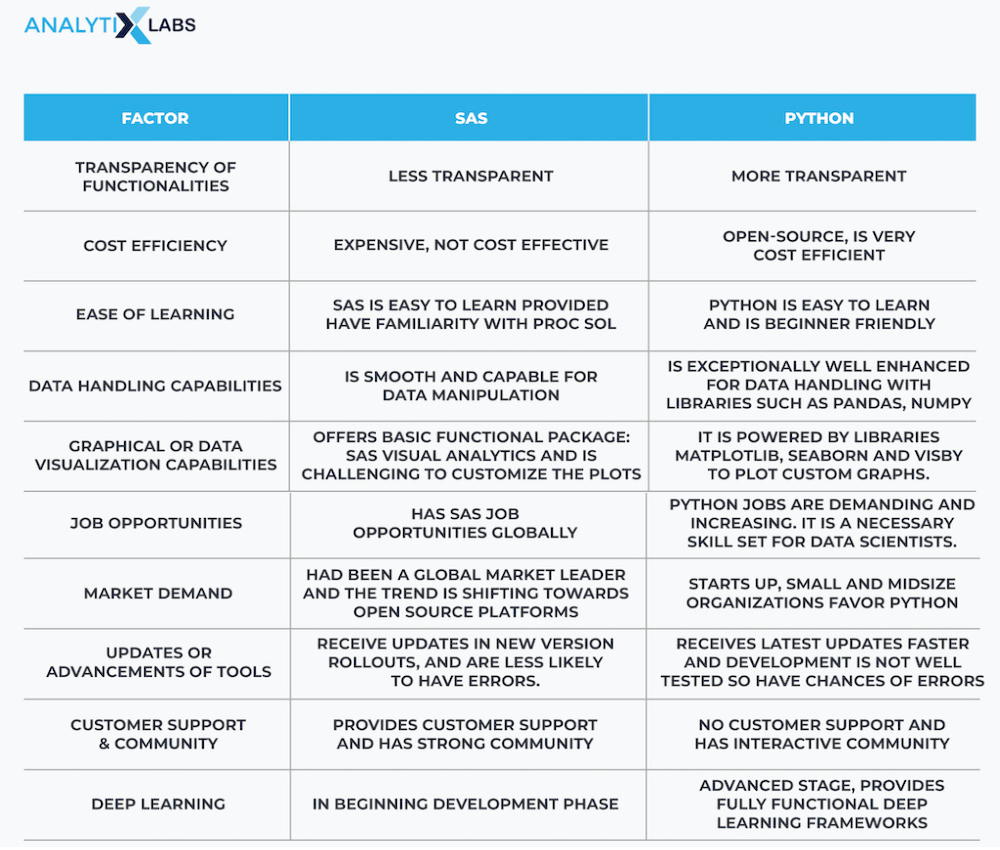
Skills Required for SAS Analyst
The following are the skills important for an analyst in one’s SAS career:
Statistical adeptness
SAS stands for Statistical Analysis System, meaning Statistics is the pillar of SAS. One may not make the most of the tool if one is not well-versed in basic and advanced Statistics. Topics such as descriptive and inferential Statistics, ANOVA, Regression Modeling, time series analysis, and forecasting are vital for working with SAS.
Programming and Querying Languages
SAS Analysts are required to have good knowledge of Visual Basic and SQL. PROC SQL is essential for learning and working with SAS. Understanding these languages supports the SAS analysts in conducting statistical analyses, data manipulation, creation of data warehouses, and writing code for data structures.
Problem-solving and Logical thinking Ability
Data analysis of any sort cannot exist without the skills of problem-solving. One needs to have a solution-oriented mindset and an eye for detail. SAS analysts and programmers must identify challenges, seek to implement their solutions via programming, and deploy those resolutions. One can also find efficient ways to reuse the written codes.
Along with problem-solving ability, one must also possess and also have sharp logical thinking ability. As codes are nothing but segregated pieces of logic consolidated in one main script hence, SAS analysts must have the logical understanding to build such codes.
Curiosity
Analysts must be like detectives, curious and always eager to learn, investigate and experiment to find more efficient task performance. Similarly, to grow deeper in your SAS career, analysts must be self-motivated to learn.
Teamwork
Working on a project is never a stand-alone activity and process. It requires teamwork and the efforts of all team members. SAS analysts must also possess effective oral communication.
They must also have strong written skills to draft documentation and record project findings. The SAS analyst and programmers must also have leadership skills to direct the team and lead a project.
Time management
Working on multiple projects is a day-in and day-out task for any analyst. SAS programmers must also handle numerous assignments and know how to manage their time and which task to prioritize, maintaining the project timelines.
Customer service
At the end of the day, SAS programmers provide solutions to business users and hence must keep the user’s or customers’ requirements in mind. This can also be viewed as one way of serving clients.
Curating code dashboards, presentations, and documentation must adhere to the business specifications, serve the clients, and is easy for them to read and use.
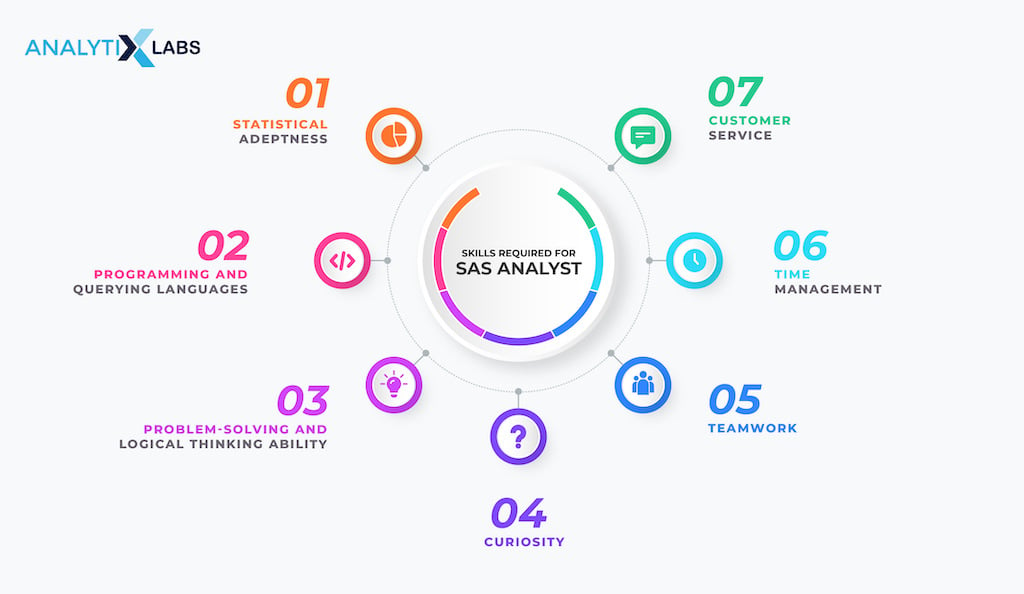
Conclusion
SAS skills have huge demand and a lot of job openings. As we looked in the section on what is SAS certification, there are credentials across different categories based on domain expertise and interest. Getting SAS certification can boost your career and provide immense growth. SAS-certified individuals and professionals have greater credibility.
Between SAS and Python, which is better is not a straightforward answer as both have different aims catering to different sets of users. SAS is heavy in PROC SQL and statistical techniques, having many jobs in the finance and banking industry, whereas Python is widely applicable for data science, web, and software development.
If you have been wondering how to learn SAS, then Analytixlabs offers various courses in which SAS is included in the curriculum.
FAQs
- What is SAS best used for?
Statistical Analysis Software, or SAS, is a command-driven software package. It is a popular and extensively used statistical software package amongst researchers, academicians, and industry professionals.
It is primarily used for quantitative methodologies, including statistical analysis, and data visualization, and for advanced analytical processes, such as predictive analytics and business intelligence. SAS is only designed for Windows operating systems.
- Is SAS important for data analytics?
Across industries, SAS has been extensively used as its main resource for data analysis. SAS does provide descriptive analytics and visualizes data using functional graphs. It can be used for advanced analytics such as data mining, machine learning, and time series by upgrading the SAS versions. It is a powerful tool for task automation via macros and for executing SQL queries.
- Does SAS have a future?
SAS is a global market leader and has been the first statistical tool along with SPSS, to drive data-based results within minutes rather than writing codes in Java and C++.
With changing times, we upgrade the technologies based on need, and SAS may not be as competent as its counterpart Python. Yet, it has its niche, and large-scale financial corporations still use SAS as it is a GUI-based tool sufficing business needs.
- Are SAS skills in demand?
Yes, SAS skills are in demand, and a global market leader. Large organizations in industries such as banking, insurance, manufacturing, pharmaceuticals, and government agencies apply SAS to solve their business requirements.

